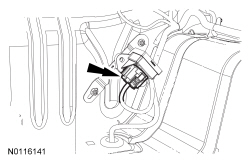SECTION 310-00: Fuel System — General Information
| 2014 Mustang Workshop Manual
|
GENERAL PROCEDURES
| Procedure revision date: 01/07/2013
|
Fuel System Pressure Release
 WARNING: Do not smoke, carry lighted tobacco or have an open flame of any type when working on or near any fuel-related component. Highly flammable mixtures are always present and may be ignited. Failure to follow these instructions may result in serious personal injury.
WARNING: Do not smoke, carry lighted tobacco or have an open flame of any type when working on or near any fuel-related component. Highly flammable mixtures are always present and may be ignited. Failure to follow these instructions may result in serious personal injury.
 WARNING: Do not carry personal electronic devices such as cell phones, pagers or audio equipment of any type when working on or near any fuel-related component. Highly flammable mixtures are always present and may be ignited. Failure to follow these instructions may result in serious personal injury.
WARNING: Do not carry personal electronic devices such as cell phones, pagers or audio equipment of any type when working on or near any fuel-related component. Highly flammable mixtures are always present and may be ignited. Failure to follow these instructions may result in serious personal injury.
 WARNING: Before working on or disconnecting any of the fuel tubes or fuel system components, relieve the fuel system pressure to prevent accidental spraying of fuel. Fuel in the fuel system remains under high pressure, even when the engine is not running. Failure to follow this instruction may result in serious personal injury.
WARNING: Before working on or disconnecting any of the fuel tubes or fuel system components, relieve the fuel system pressure to prevent accidental spraying of fuel. Fuel in the fuel system remains under high pressure, even when the engine is not running. Failure to follow this instruction may result in serious personal injury.
NOTE:
Vehicle's with 3.7L or 5.0L engines have 1 Fuel Pump Control Module (FPCM) located on the driver's side of the spare tire stowage compartment.
NOTE:
Vehicle's with 5.8L engines have 2 Fuel Pump Control Module (FPCM) located on the driver's and passenger's side of the spare tire stowage compartment.
Disconnect the Fuel Pump Control Module (FPCM) electrical connector(s).
- Start the engine and allow it to idle until it stalls.
- After the engine stalls, crank the engine for approximately 10 seconds to make sure the fuel injection supply manifold pressure has been released.
- Turn the ignition switch to the OFF position.
- When the fuel system service is complete, connect the
electrical connector(s).
NOTE:
It may take more than one key cycle to pressurize the fuel system.
Cycle the ignition key and wait 3 seconds to pressurize the fuel system. Check for leaks before starting the engine.
- Start the vehicle and check the fuel system for leaks.
 WARNING: Do not smoke, carry lighted tobacco or have an open flame of any type when working on or near any fuel-related component. Highly flammable mixtures are always present and may be ignited. Failure to follow these instructions may result in serious personal injury.
WARNING: Do not smoke, carry lighted tobacco or have an open flame of any type when working on or near any fuel-related component. Highly flammable mixtures are always present and may be ignited. Failure to follow these instructions may result in serious personal injury.
